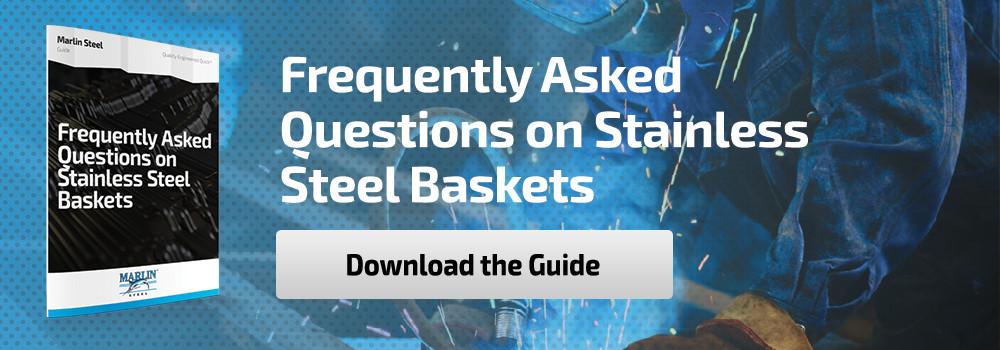 You may be familiar with the Inconel® family of high-nickel alloys. This series of alloys is well-known for its performance in extreme heat conditions—which makes each Inconel® variant extraordinarily popular for use in furnace applications such as heat treating or annealing steel.
You may be familiar with the Inconel® family of high-nickel alloys. This series of alloys is well-known for its performance in extreme heat conditions—which makes each Inconel® variant extraordinarily popular for use in furnace applications such as heat treating or annealing steel.
However, what differences exist between the various formulations of Inconel®? This is a question that Marlin’s engineers are asked frequently. In fact, one recent customer who had a process wherein they’d place their products (and baskets) in a 1,975° Fahrenheit furnace for one hour wondered which of three different Inconel® alloys would be best for their application: 330, 600, or 625?
To help answer this question, here’s a quick comparison of these three high-heat specialty metals:
Incoloy® 330
While it is a part of the Inconel® family of heat-resistant metal alloys, the 330 variant is more commonly known by the name Incoloy® or RA330. With a nickel content ranging between 34% and 37% and 17-20% chromium, Incoloy® is incredibly resistant to oxidation at high temperatures—up to 2,100°F (1,148°C)—as well as carburizing and nitriding.
Rapid changes in temperature (which are common in heat treat applications) are not as much of an issue for alloy 330, since it is resistant to thermal shock. Like many Inconel® alloys, 330 maintains a great degree of its tensile strength in extreme temperatures compared to plain steel alloys.
In fact, in their Alloy Performance Guide, Rolled Alloys lists RA330 as having “Better” (meaning above average) performance for strength, oxidation resistance, carburization resistance, and oxidizing sulfur resistance while being rated as “Best” for thermal shock resistance among the high-temperature alloys they offer.
Inconel 600®
Inconel 600® is a popular variety of the material that is resistant to oxidation at high temperatures. At a minimum nickel content of 72%, this metal alloy has more than twice the nickel content of Incoloy 330®.
While this helps to increase the metal’s high-temp oxidation and carburization resistance, it does leave the metal vulnerable to sulfur attack. As noted in the Rolled Alloys guide, Inconel 600® for use in oxidizing sulfur, reducing sulfur, or molten metals (such as copper, zinc, or magnesium). However, it does have good tensile strength, above-average oxidation and thermal shock resistance, and top-notch carburization resistance. It also has incredible chloride stress corrosion cracking resistance if it is stress relieved.
Inconel 625®
When it comes to nickel content, Inconel 625® falls between the 330 and 600 alloys at 58% minimum nickel. At 20-23%, chromium is the next most abundant element in this alloy. The addition of columbium and molybdenum adds to the alloy’s performance at various temperatures—which is why Inconel 600® is noted for having superb strength and toughness in temperatures ranging from -32°F (0°C) to 2,000°F (1,093°C).
The alloy is also noted for having a particularly high creep rupture strength, fatigue resistance, and chloride pitting/crevice corrosion resistance. Meanwhile, the metal is remarkably easy to weld compared to other Inconel® alloys. The recommended uses of this metal include jet engine exhausts, flare stacks, seawater equipment, and chemical plant equipment because of its high chemical and temperature resistance qualities.
625’s resistance to oxalic acid is particularly high compared to other materials—in a corrosion test by Rolled Alloys, the material experienced only 6.0 mils/year of corrosion in a 10% boiling oxalic acid solution. For comparison, 316L stainless steel experienced 44.9 mils/year of corrosion in the same solution. However, its sulfuric acid resistance was less impressive, experiencing 37 mils/year of corrosion in a 10% concentration bath.
Which is the Best for Your Application?
The answer is: “it depends.” What does your process look like, and what chemicals, if any, are involved? Inconel 600® is great for temperature tolerance, but not as good as 330, and is wholly unsuited for any application involving the use of sulfuric compounds. Meanwhile, 330 is good at resisting oxidizing sulfur, but not reducing sulfur. The 625 variant is generally resistant to most acids, but may be costly compared to the less nickel-rich 330 alloy.
For straight temperature resistance, any one of these three metals could serve your needs in the around-2,000°F range, but the other processes you use the basket for might decide what specific alloy you want to use.
Need help choosing the best metal alloy to use for your custom parts handling and heat treatment baskets? Contact the experts at Marlin Steel to get advice from a degreed mechanical engineer today—or to set up a custom basket order now!



.gif)


